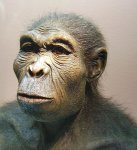Humans
are members of the genus Homo
![]() .
Modern people are Homo sapiens
.
Modern people are Homo sapiens
![]() .
However, we are not the only species of humans who have ever lived.
There were earlier species of our genus that are now extinct.
In the past, it was incorrectly assumed that human evolution was a relatively
straightforward sequence of one species evolving into another. We now
understand that there were times when several species of humans and even other hominins were alive. This complex pattern of evolution emerging from the
fossil record has been aptly described as a luxuriantly branching bush on
which all but one twig has died off. Modern humans are that last living
twig. Complicating this evolutionary history even
more is the realization that our ancestors very likely mated successfully
with members of other closely related species from time to time. As a
consequence, our inherited gene pool was enriched by added genetic
diversity. This sort of genetic mixing has recently been documented
for Neandertals and early modern
Homo sapiens living 40-60,000 years ago. It is also likely
that there were genetic bottle
necking events that periodically reduced our diversity. That
largely accounts for the fact that despite our huge human population today,
we are remarkably similar genetically compared to other primate species.
It also explains why we are now the only surviving hominin species.
.
However, we are not the only species of humans who have ever lived.
There were earlier species of our genus that are now extinct.
In the past, it was incorrectly assumed that human evolution was a relatively
straightforward sequence of one species evolving into another. We now
understand that there were times when several species of humans and even other hominins were alive. This complex pattern of evolution emerging from the
fossil record has been aptly described as a luxuriantly branching bush on
which all but one twig has died off. Modern humans are that last living
twig. Complicating this evolutionary history even
more is the realization that our ancestors very likely mated successfully
with members of other closely related species from time to time. As a
consequence, our inherited gene pool was enriched by added genetic
diversity. This sort of genetic mixing has recently been documented
for Neandertals and early modern
Homo sapiens living 40-60,000 years ago. It is also likely
that there were genetic bottle
necking events that periodically reduced our diversity. That
largely accounts for the fact that despite our huge human population today,
we are remarkably similar genetically compared to other primate species.
It also explains why we are now the only surviving hominin species.
The striking similarities in
appearance between the human genus Homo and our ancestors, the genus
Australopithecus
![]() ,
is sufficient reason to place us both into the same biological
tribe (Hominini
,
is sufficient reason to place us both into the same biological
tribe (Hominini
![]() ).
Both genera are bipedal and habitually upright in
posture. Humans have been somewhat more efficient at this mode of
locomotion. Like australopithecines
).
Both genera are bipedal and habitually upright in
posture. Humans have been somewhat more efficient at this mode of
locomotion. Like australopithecines
![]() , early humans were light in
frame and relatively short. They were only about 3
ft. 4 in. to 4 ft. 5 in. tall (100-235 cm) and weighed around 70 pounds (32
kg) The evolution of larger bodies occurred later in human
evolution. The differences between australopithecines and early humans
are most noticeable in the head. Humans developed
significantly larger brains and relatively smaller faces with progressively
smaller teeth and jaws. In addition,
humans became ever more proficient in developing cultural technologies to
aid in their survival, while the australopithecines did not.
, early humans were light in
frame and relatively short. They were only about 3
ft. 4 in. to 4 ft. 5 in. tall (100-235 cm) and weighed around 70 pounds (32
kg) The evolution of larger bodies occurred later in human
evolution. The differences between australopithecines and early humans
are most noticeable in the head. Humans developed
significantly larger brains and relatively smaller faces with progressively
smaller teeth and jaws. In addition,
humans became ever more proficient in developing cultural technologies to
aid in their survival, while the australopithecines did not.
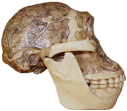 |
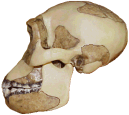 |
|
| Late australopithecine | Early transitional human |
The immediate ancestors of early
humans were most likely late australopithecines. At present,
the leading contender for that ancestral species is Australopithecus
garhi ![]() or possibly Australopithecus africanus.
or possibly Australopithecus africanus. ![]()
There may have
been one or possibly two species of
the first humans living in East Africa--Homo rudolfensis ![]() and
Homo habilis
and
Homo habilis
![]() .
The few rudolfensis fossils
that have been found are somewhat earlier, dating
about 2.4-1.6 million years ago, while the more
common habilis
remains are around 1.9-1.4 million years old.
Rudolfensis apparently was
a bit taller and relatively larger brained on average. However, many paleoanthropologists consider the
differences to be too slight to warrant a separate species designation.
Some have suggested that rudolfensis were males and habilis
were females.
As a result, they classify them both as a single species--Homo habilis.
That is the approach taken in this tutorial.
.
The few rudolfensis fossils
that have been found are somewhat earlier, dating
about 2.4-1.6 million years ago, while the more
common habilis
remains are around 1.9-1.4 million years old.
Rudolfensis apparently was
a bit taller and relatively larger brained on average. However, many paleoanthropologists consider the
differences to be too slight to warrant a separate species designation.
Some have suggested that rudolfensis were males and habilis
were females.
As a result, they classify them both as a single species--Homo habilis.
That is the approach taken in this tutorial.
The evolution of the genera Homo and Paranthropus beginning around 2.5 million years ago coincides with the beginning of a period of prolonged climate instability in Africa. The overall trend was towards cooling and drying, but along the way there were considerable climate fluctuations. It is likely that selection for the ability to adapt to these environmental changes resulted in the emergence of humans with their larger, more capable brains.
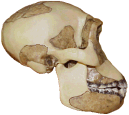 |
 |
||
| Homo habilis | |||
Early transitional human fossils were first discovered in 1960 by Louis and Mary Leakey at Olduvai Gorge in Tanzania. The Leakeys named them Homo habilis (Latin for "handy or skilled human") because they apparently made stone tools. Similar fossils were found at East Lake Turkana in Kenya by Richard Leakey's team of fieldworkers that began searching there in 1969. These latter specimens were named Homo rudolfensis after Lake Rudolf (i.e., the former name for Lake Turkana).
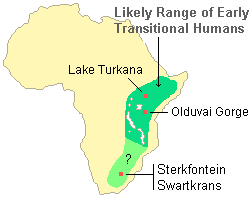 |
So far, conclusive evidence of Homo habilis has been found only in the Great Rift Valley system of East Africa. However, their ultimate geographic and time ranges may have been somewhat larger. Early transitional human fossils also have been found in South Africa in the caves at Sterkfontein and Swartkrans in apparent association with australopithecines. However, not all paleoanthropologists agree that these fossils should be considered Homo habilis.
Early transitional humans had brains that on average were about 35% larger than those of Australopithecus africanus. In fact, it is beginning with Homo habilis that our ancestors finally had brains that were consistently bigger than those of the great apes. Ajit Varki and his team of geneticists at the University of California San Diego campus have discovered a small genetic difference between humans and apes that may account for the progressive increase in the size of human brains. People, but not apes, have a gene that stops the production of N-glycolylneuramine acid. Using "molecular clock analysis," the U.C.S.D. researchers determined that this gene entered the human evolutionary line as a result of a mutation 2.7 million years ago. While it is presumed that the australopithecines lacked this gene, there is no direct evidence.
|
|
As the early human cranium, or brain case, began to enlarge in response to increased brain size, the mouth became smaller. In comparison to the australopithecines, the early humans had smaller teeth, especially the molars and premolars. This suggests that they mostly ate softer foods. An analysis of the wear patterns on their teeth indicates that they had diverse diets that included a wide range of plants and meat. As noted previously, the body size of Homo habilis was not significantly larger than the early hominins that preceded them. Likewise, the arms of habilis and their australopithecine ancestors were relatively long compared to ours. The modern human body size and limb proportions began to appear with the next species in our evolution--Homo erectus.
